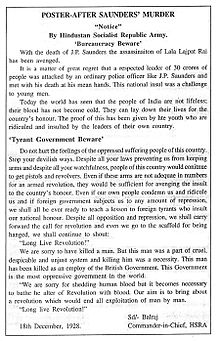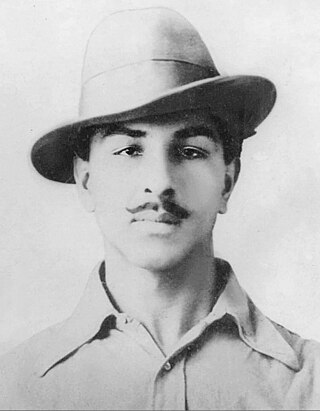
Bhagat Singh was an Indian anti-colonial revolutionary, who participated in the mistaken murder of a junior British police officer in December 1928 in what was to be retaliation for the death of an Indian nationalist. He later took part in a largely symbolic bombing of the Central Legislative Assembly in Delhi and a hunger strike in jail, which—on the back of sympathetic coverage in Indian-owned newspapers—turned him into a household name in the Punjab region, and after his execution at age 23 into a martyr and folk hero in Northern India. Borrowing ideas from Bolshevism and anarchism, the charismatic Singh electrified a growing militancy in India in the 1930s, and prompted urgent introspection within the Indian National Congress's nonviolent but eventually successful campaign for India's independence.

The Legend of Bhagat Singh is a 2002 Indian Hindi-language biographical period film directed by Rajkumar Santoshi. The film is about Bhagat Singh, a revolutionary who fought for Indian independence along with fellow members of the Hindustan Socialist Republican Association. It features Ajay Devgan as the titular character along with Sushant Singh, D. Santosh and Akhilendra Mishra as the other lead characters. Raj Babbar, Farida Jalal and Amrita Rao play supporting roles. The film chronicles Singh's life from his childhood where he witnesses the Jallianwala Bagh massacre until the day he was hanged to death before the official trial dated 24 March 1931.

Ram Prasad Bismil was an Indian poet, writer, revolutionary and an Indian freedom fighter who participated in the Mainpuri Conspiracy of 1918, and the Kakori Conspiracy of 1925, and fought against British Raj British Imperialism. He also had a good command over Urdu and the Hindi languages and was an accomplished poet, composing in these languages using the pen names Ram - राम , Agyat and Bismil A person who has been killed - बिस्मिल, the latter through which he became famously known by.
The Revolutionary movement for Indian Independence was part of the Indian independence movement comprising the actions of violent underground revolutionary factions. Groups believing in armed revolution against the ruling British fall into this category, as opposed to the generally peaceful civil disobedience movement spearheaded by Mahatma Gandhi.
Hindustan Socialist Republican Association (HSRA), previously known as the Hindustan Republican Army and Hindustan Republican Association (HRA), was a radical left-wing Indian revolutionary organisation were founded by Sachindranath Sanyal - Shanyal Babu and later on it other joined. After changes of Shaheed-E Aazam Bhagat Singh's new ideology and the influence of the Russian Revolution, they held meetings in Feroz Shah Kotla Maidan and added the word socialist to their name. Ram Prasad Bismil, Ashfaqulla Khan, Sachindra Nath Bakshi, Sachindranath Sanyal and Jogesh Chandra Chatterjee were then leaders. HRA's manifesto titled The Revolutionary and written constitution were produced as evidence in the Kakori conspiracy case of 1925.
Manmath Nath Gupta was an Indian Marxist revolutionary writer and author of autobiographical, historical and fictional books in Hindi, English and Bengali. He joined the Indian independence movement at the age of 13 and was an active member of the Hindustan Republican Association. He participated in the famous Kakori train robbery in 1925 and was imprisoned for 14 years. On release from jail in 1937, he started writing against the British government. He was sentenced again in 1939 and was released in 1946 just a year before India's independence in 1947. He has written several books on the history of the Indian struggle for independence from a revolutionary's point of view, including They Lived Dangerously – Reminiscences of a Revolutionary. He was also the editor of the Hindi literary magazine Aajkal.

The Kakori Train robbery was a train robbery that took place at Kakori, a village near Lucknow, on 9 August 1925, during the Indian independence movement against the British rule in India. It was organized by the Indian revolutionaries of Hindustan Republican Association (HRA).

Ashfaqulla Khan was an Indian independence activist in the Indian independence movement against British rule and co-founder of the Hindustan Republican Association, later to become the Hindustan Socialist Republican Association.
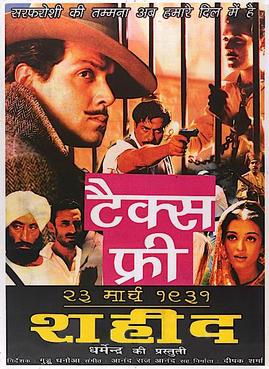
23rd March 1931: Shaheed is a 2002 Indian Hindi-language historical biographical film about Bhagat Singh, directed by Guddu Dhanoa which depicts the events leading up to the hanging of Singh and his companions Shivaram Rajguru and Sukhdev Thapar on 23 March 1931. The film stars Bobby Deol as Singh, his elder brother Sunny Deol as Chandra Shekhar Azad and Amrita Singh in her comeback role as Vidyavati Kaur.
Keshab Chakravarty was an Indian freedom fighter and one of the youth involved in the Kakori conspiracy.
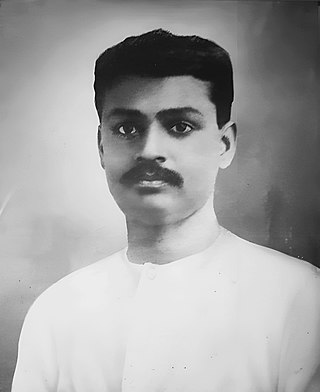
Sachindra Nath Sanyal was an Indian revolutionary and co-founder of the Hindustan Republican Association that was created to carry out armed resistance against the British Empire in India. He was a mentor for revolutionaries like Chandra Shekhar Azad, Jatindra Nath Das, and Bhagat Singh.
Prem Kishan Khanna was an active member of the Hindustan Republican Association from Shahjahanpur U.P. Khanna was a contractor for Indian Railways. He was a close associate of noted revolutionary Ram Prasad Bismil.
Durgavati Devi, popularly known as Durga Bhabhi, was an Indian revolutionary and freedom fighter. She was one of the few women revolutionaries who actively participated in armed revolution against the ruling British Raj. She is best known for having accompanied Bhagat Singh on the train journey in which he made his escape in disguise after the killing of John P. Saunders. Since she was the wife of another Hindustan Socialist Republican Association (HSRA) member Bhagwati Charan Vohra, other members of HSRA referred to her as Bhabhi and became popular as "Durga Bhabhi" in Indian revolutionary circles.
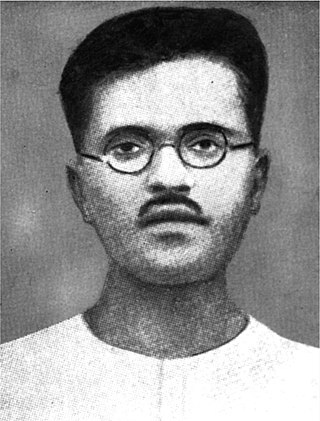
Bhagwati Charan Vohra was an Indian revolutionary, associated with Hindustan Socialist Republican Association. He was an ideologue, organiser, orator and campaigner.

Chandrashekhar is an Indian historical drama and biopic television series based on the life on a freedom fighter Chandra Shekhar Azad. It premiered on 12 March 2018 on Star Bharat and is produced by Anirudh Pathak.
Gaya Prasad Katiyar was an Indian revolutionary and member of Hindustan Socialist Republican Association. He worked for India's independence and joined hands with Bhagat Singh and Chandrasekhar Azad.

Shiv Verma was an Indian Marxist revolutionary and a member of the Hindustan Socialist Republican Association.

Bejoy Kumar Sinha was an Indian revolutionary and member of Hindustan Socialist Republican Association.

Jaidev Kapoor was an Indian revolutionary who worked for the Hindustan Republican Association along with Chandra Shekhar Azad and Bhagat Singh. As a teenager, he was interested to join the HRA and later, he met Azad and became a comrade of Singh.
Communists were actively involved in Indian independence movement through multiple series of protests, strikes and other activities. It was a part of revolutionary movement for Indian independence. Their main thrust was on organising peasants and working classes across India against the British and Indian capitalists and landlords.


